#Spotted lungfish
Explore tagged Tumblr posts
Text






#Australian lungfish#Neoceratodus forsteri#South American lungfish#Lepidosiren paradoxa#Marbled lungfish#Protopterus aethiopicus#Gilled lungfish#Protopterus amphibius#West African lungfish#Protopterus annectens#Spotted lungfish#Protopterus dolloi#lungfish#fishes#marine biology#fish#fishblr#aquatic life#aquatic#poll#my polls#random polls#poll time#tumblr polls#polls#polls on tumblr#tumblr poll#polls polls polls#polls are fun
175 notes
·
View notes
Text
Daily fish fact #756
Spotted lungfish!

It rarely has to aestivate as its habitat, middle and lower Congo River basin, does not often dry up completely. Like other lungfish, it lacks marginal teeth and instead uses dental plates to crush its food.
75 notes
·
View notes
Text
It seems most of my favourite fish are just very long. A short collection:






(Is two sturgeon species cheating? Surely not. They're as different as European perches and yellow perches!)
im a big fan of long fish. sturgeon, arapaima, gar. just normal fish that have been stretched out
#long is the way to go#sturgeon#atlantic sturgeon#siberian sturgeon#black marlin#marlin#pike#spotted lungfish#slender lungfish#just to hammer it in... long :)#lamprey#northern brook lamprey
5K notes
·
View notes
Text
Round 2 - Chordata - Dipnoi
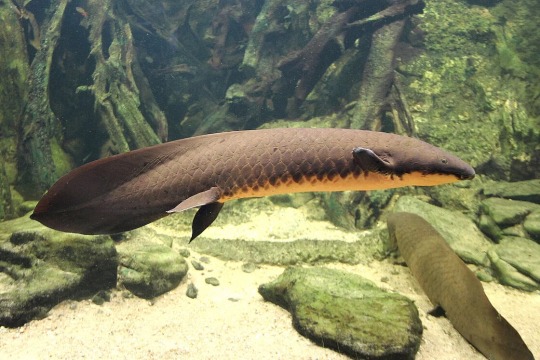
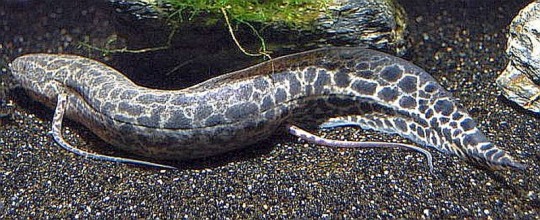
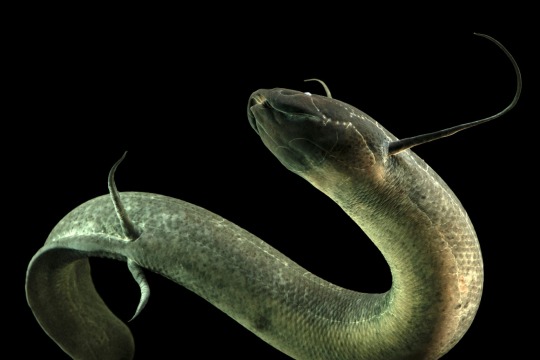
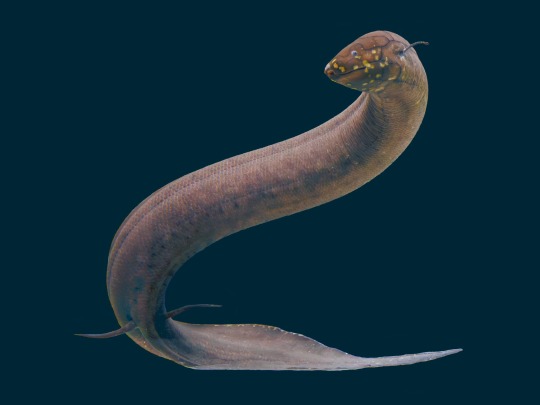
(Sources - 1, 2, 3, 4)
Dipnoi is a class of Sarcopterygiian fish commonly called “lungfish”. While widely distributed since the Early Devonian, today only 6 species remain. They are the closest living relatives to tetrapods (amphibians, reptiles, and mammals).
Like other Sarcopterygiians, lungfish have lobed, bony fins and a well-developed internal skeleton. True to their name, they have a highly specialized respiratory system which includes lungs, subdivided into numerous smaller air sacs. Most extant lungfish species have two lungs, with the exception of the Australian Lungfish (Neoceratodus forsteri), which has only one. The Australian Lungfish can breathe through its gills without needing air from its lung, but in all other species the gills are too atrophied to allow for adequate gas exchange. Lungfish have unique dentition, bearing fan-shaped tooth plates called odontodes, which are used to crush hard shelled organisms. Some groups have ridges on these tooth plates that form occluding blades. They are omnivorous, feeding on fish, insects, crustaceans, worms, mollusks, amphibians, and plant matter. African and South American Lungfish are capable of surviving seasonal drying-out of their habitats by burrowing into mud and estivating throughout the dry season.

(own work)
Propaganda under the cut:
The Australian Lungfish has existed in Australia for at least 100 million years, making it a true living fossil and one of the oldest living vertebrate genera on the planet. It is the most primitive surviving member of the ancient Dipnoi lineages.
The Marbled Lungfish's (Protopterus aethiopicus) genome contains 133 billion base pairs, making it the largest known genome of any vertebrate. The only organisms known to have more base pairs are the amoeboid Polychaos dubium and the flowering plant Paris japonica at 670 billion (possibly) and 150 billion, respectively.
The Spotted Lungfish (Protopterus dolloi) can aestivate on land by surrounding itself in a layer of dried mucus.
An Australian Lungfish named “Granddad” at the Shedd Aquarium in Chicago lived to be 109 years old, before he had to be euthanized due to an age-related decline in health. The current oldest Australian Lungfish is now “Methuselah”, who lives at the California Academy of Sciences, and is around 100 years old. Methuselah has been described as "mellow" by her keeper. She is also noted to like belly rubs, back rubs, and fresh figs.
Australian Lungfish are one of the cutest animals on the planet and I want a life-sized plushie/body pillow of one
86 notes
·
View notes
Text

Not much else to say other than it's a concept of a post syszgy Trisolaran. The black orbs are their eyes and glowing spots are how they communicate. They use their first two pairs of feet and antennae for tool manipulation, albeit most of their tools look alien to use thanks to their "hand" structure. It's of important note that the claws did not evolve due to some destined path of sapience, but because I imagine most life on Trisolaris burrows before going dormant. Partially to protect against their unstable environment, partially to protect against other "animals" and individuals that hydrate before them. Their bodies are supported by hydrolic pressure, fixable cartilage rods, and thin bones.
When they breed, I imagine a pair of Trisolarans stacks one on top the other before wrapping themselves in some burried mud caccon, similar to lungfish. Inside the caccon, the pair secrete a slimy "digestive" fluid that breaks down their bodies in a process like caterpillar metamorphosis. The "parent soup" then quickly develops into a giant "fetus" which breaks into 3-5 individuals depending the on age and weight of parents.
As for their religions, I imagine most of them involve some type of Soma coin flip philosophy where an individual has a 50% chance of becoming their offspring, with this idea coming from the fact that their offspring inherent some of their parents memories. That and a drunken god holding their solar system on some plater and their constant teter-toddering is what causes their suns to move in an eccentric dance.
#low poly#blender#cosmic horror#spec evo#three body#hard sci fi#hard science fiction#3 body problem#scifi#scifiart#starfish aliens#Aliens are dicks
10 notes
·
View notes
Note
About Whitelake's Boys,
Are they based on any specific fish? I've seen mentions of coelacanths and lungfish, what's the pattern and fin situation?
How did they get to the lake?? Doesn't seem like an easy place to get to when they're human sized.
Bc reproduction is, like, the centerpiece will it be fade-to-black to something else?
I am looking with great interest 👀
They're mostly based on coelacanths and lungfish, indeed! Coelacanths and lungfish are our closest fishy relatives, so I figured it was appropriate. I've also taken some inspiration from other "living fossil" fish like bichirs and gars, a little bit from anglerfish and some from amphibians (axolotls! <3), seals, platypi and "fishapods" aka extinct early ancestors of tetrapoda.
So, pattern and fin-wise... Lemme do a quick sketch.

Moon has a blue back with golden spotting, Sun has a red back with yellow striping. Both have mostly maroon fins, but the caudal fins are orange and Moon's head fin is blue and spotted while Sun's head fins have a gradient from maroon to yellow. So basically very similar to their canon colours! Their heads and torsos are parti-coloured as well. I have looked at real fish for some pattern inspiration, with Sun being mostly akin to a red-striped killifish and Moon being most similar to a celestial pearl danio, though if I ever manage to draw them I'll also try to make their patterns resemble those of local fish like pikes, arctic chars, rudds and minnows.
unlike coelacanths and lungfish, waterfolk (at least these ones—waterfolk between continents may differ!) have heterocercal tails like, for example, sharks and some early lobe-finned fish. their fins are lobed like those of coelacanths and lungfish, and the lobes of their pectoral fins have developed into arms.
re: getting into the lake... presumably it happened with great difficulty and stubbornness XD It's worth noting that waterfolk are not marine people; they live in fresh and brackish water. Travelling through rivers, even dragging themselves through eutrophic shallows, is within their range of typical behaviour. The lake they live in is connected via small rivers and streams to the lake they moved from, as well as eventually to the brackish sea to the south.
re: reproduction, I haven't decided yet! I'm not sure if people will enjoy my writing style when it comes to nsfw content; with that in mind, I might fade to black in the main story and publish the nsfw parts in a separate work on ao3? We'll see! 🤔
thank you for asking! 🐟💖
8 notes
·
View notes
Note
favorite deep sea creature?
sorry this one took so long to answer. it's also very long. but I feel like you knew what you were getting into when you asked tumblr user "abyssalzones" what his favorite deep sea creature is.
now immediately my mind jumped to coelacanths because they're among my favorite fish Ever for a multitude of reasons, such as (but not limited to):
-their mystique (their fossilized ancestors were initially discovered in the 19th century, and due to their illusive nature were thought to have gone extinct at the end of the Cretaceous period until one was found alive by an unknown(?) fisherman off the coast of South Africa, and from there the discovery was accredited to museum curator Marjorie Courtenay-Latimar who spotted it in the day's catch. however it's worth mentioning fishermen in the eastern South African region may have known about the species before then. kind of a 'who can say if it wasn't written down' situation.)
-their beautiful blueness (others have waxed poetic about their appearance more skillfully than I, but just look at this guy. wow. albeit I have to wonder if how blue they appear is very dependent on lighting but whatever he's beautiful)

-and, finally, their importance as lobe-finned fish! (the two extant species of Coelacanth today- alongside lungfish, who are also incredibly cool- hold a unique position in taxonomy and evolutionary history as the only living non-tetrapod sarcopterygians that we know of ^_^ they used to be much more dominant as freshwater predators, but then the great dying came along and they suffered a significant decline. so, essentially, these guys are survivors! ...if you felt it necessary to frame it as such. and "sarcopterygian" more specifically describes them as belonging to the clade 'Sarcopterygii', which classifies them as lobe-finned bony fish. this contrasts the other clade of bony fish, Actinopterygii, which describes ray-finned bony fish. in essence, they are the great-great-great-great-ad-nauseum-grandparents of all tetrapods! very very important animals from a grander biological perspective.)
...however, after typing all of this out, I realize this is a little bit of a cop-out. Coelacanths, as cool as they are, are actually not the deepest of deep-sea fish. It's difficult to get the exact numbers on their whereabouts as, previously stated, they're pretty elusive guys, but generally during the daytime they're found about 100-500 meters deep, resting in caves and saving their energy for nocturnal reef-feeding. apparently they've been found to migrate deeper as well, but it still feels a little disingenuous (to me) to say that they're truly deep-sea animals.
...so if I want to live up to my username, I need to take you on a journey. to the abyssal zone. where you will find some truly terrifying, near-alien creatures, straight from the pits of Dante Alighieri's visions of hell, or Hieronymus Bosch's bizarre garden of earthly delights...!
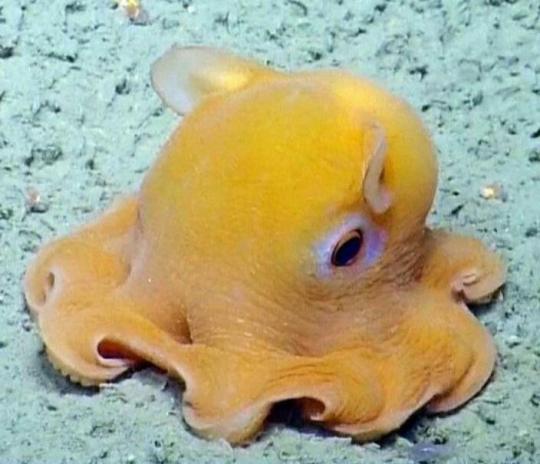
no, not that guy! get him out of here. shoo.
Instead we're going to be talking about his big brother. his... very, very big brother.
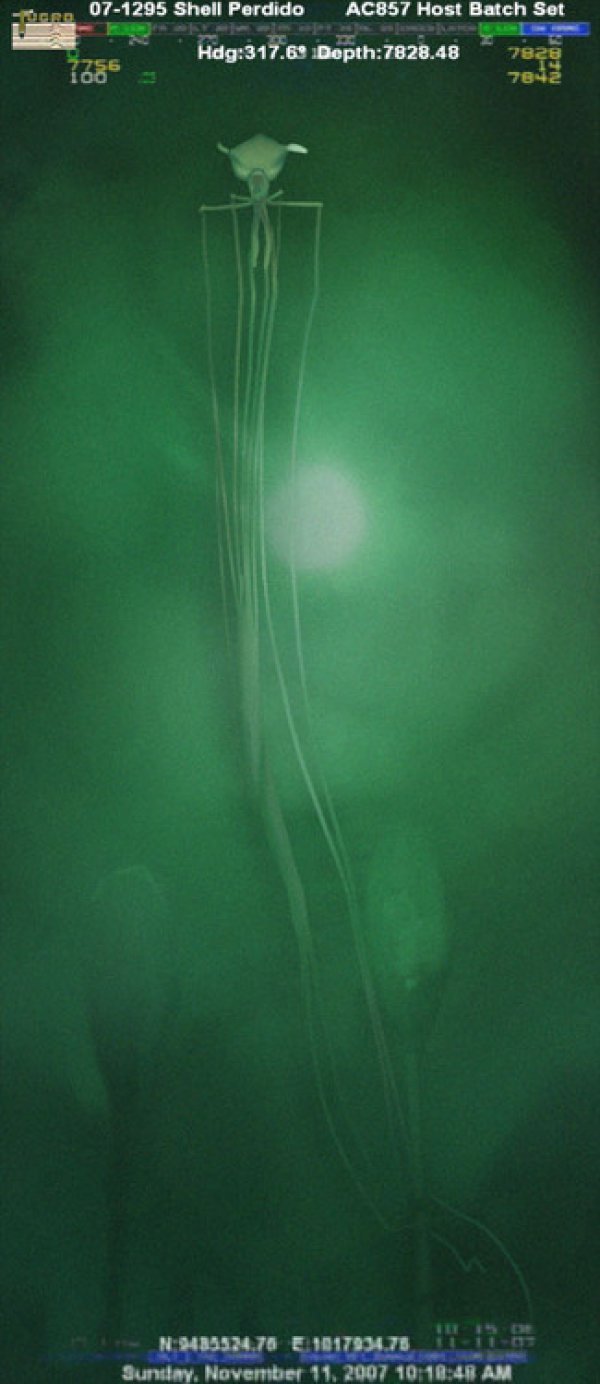
okay so chances are you've seen this photo before, it circulates quite a bit online as "BIG FUCKING SCARY THING IN THE OCEAN" and it's pretty apparent why, but I'm incredibly fond of "Scary fucking thing in the ocean" in general, and as such I think this guy is delightful. I debated on picking a couple of different, lesser-known species from the abyssal-hadal range (such as various arctic amphipods), but if I'm honest I have a soft spot for cephalopods. typical, typical I know, I should be ashamed, but in this case I can safely say the Bigfin squid (genus Magnapinna) is anything but "typical".
oh, sure, there's a level of wonder healthily exacerbated by the rarity of sightings- but that's all we have! sightings and footage! well, that and washed-up corpses dating back to 1883, all being damaged juveniles that were never properly collected. even so, their significance and oddity isn't really made apparent until you see their adult form, which first came to science's attention properly in 2001 when some very grainy footage was captured by an oil drilling ship, the Milennium Explorer, in the gulf of Mexico.
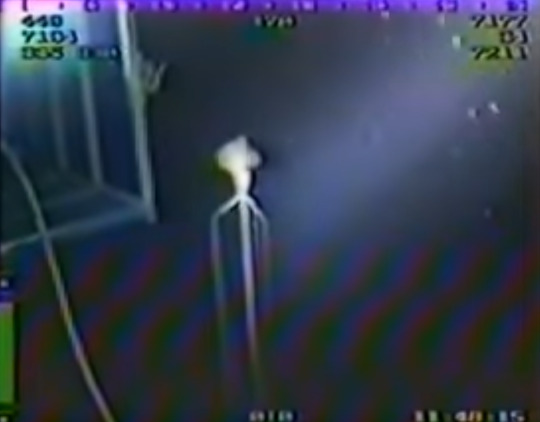
he's shy.
I say "first came to science's attention" because the Bigfin had actually been recorded prior, all the way back to 1998, but no one had really gotten up out of their chair and started dancing around at the realization of holy shit, what is this thing? and from there further work was done on properly identifying and analyzing the species based on footage.
however... it's still just footage. there has not yet been a captured live specimen, nor a well-preserved cadaver, or... really anything to tell us more about this mysterious cephalopod, other than what we can tell visually and geographically. we know it sure looks distinctive compared to various species of squid (check out the elbows on that thing), we know the largest adult specimens seem to be about 25 feet long (with estimates going up to 40 feet), and we know it might be the deepest-occurring genus of squid (we've had sightings as deep as 6,212 meters below the surface- well into the hadal zone, actually, not just the abyssopelagic), but in terms of behavior? breeding? feeding habits?? there are a lot of unanswered questions. and that's not to discredit any legitimate scientific analysis, past or present, of the bigfin, but moreso to stress that it's a very mysterious creature we don't have much data on.
I think just in general, my favorite deep-sea creatures (and this extends to just about any species, sea-dwelling or otherwise) are those that do a very thorough job of not being found. I am driven by a deep curiosity into whatever is so weird and leads such an unimaginable life to us humans that it eludes the microscope or the scalpel time and time again.
oh, and bigfin squids kind of remind me of the alien controllers that fly around your head during the xen levels in half-life. so there's that as well.
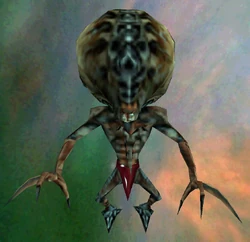

#lab notes#askbox#I am not by any means an expert so feel free to correct me if I'm wrong or misled about any of this!
6 notes
·
View notes
Note
Can I ask your top 10 fav fics ever (from any fandom, if you don't mind)?
Also, just curious, is there a story behind your name "imaginarylungfish "?
yes, you most definitely can! alright, here we go!
The Distance of Differences: this is my all-time favorite fic. it actually got me into todobakudeku for good. before reading this, i really only into tododeku and never bakudeku or todobaku. but damn, the storyline was really interesting, and the characterizations were great. i loved the dynamic between shouto, katsuki, and izuku. plus, i liked seeing how they all interacted with their classmates years later. i go back to this fic when i'm having a bad day cause i know it'll cheer me up!
Don't Say Goodbye: this one sticks out as a favorite of mine for similar reasons to the last one: an interesting storyline and great characterizations. i really liked how respectful and thoughtful sasaki and miyano were of each other (nothing new, but great to see it lasted into adulthood). plus, it was just cool to see them be able be a little family.
Ten Years, One Torch: this is my favorite tododeku fic. probably because i think the characterizations are pretty on point and because if shouto and izuku are together, then i need katsuki and eijirou to be together too lol. i just think the background ships are really spot on which helped me fall in love with this fic.
Look at Me, I Hear You: i normally am not one to find alternate universe fics enjoyable, but this was an exception (probably because the characterizations were still spot on). i really liked how katsuki and eijirou find a way to communicate with each other even with their challenges. i used to be pretty sick/disabled, so i think i have a soft spot for fics that show disabilities in a way that is just a normal part of living.
Your Hand in Mine (In Every Universe): so i'm not a huge bakudeku fan (i'm really only into bakudeku if it's todobakudeku) but this fic was really creative and i really enjoyed it. i think the characterization of katsuki was really spot on, even with the different versions of him.
Falling in Love at the Photo Shop: i think i'm a sucker for some oblivious-in-love fics like this. it's just really cute when two characters already act like a couple, then they realize they love each other. this is the story i wish was canon lol
Love, or Something Like That: kinda similar to the last fic's reasoning. oblivious-in-love and acting like a couple. it was nice to have a fic about kazurei after the christmas party/pre-time skip. this is what i wish happened lol
Bakugo Katsuki's Guide to Ignoring PTSD: ok so i know i said i don't really like alternate universe fics, but i like this one okayyy? probably because i also have ptsd and it was just really relatable. i also love how katsuki's friends are just there for him. plus, todobakudeku!
Of Duckies, Justice, and Life's Other Mysteries: ok so i haven't posted this anywhere before because it's not a finished fic (and i do hope the writer finishes it!!). but i really like this fic--it takes up my brain space lol. it feels like a cross between link click and buddy daddies, so it's up my alley. i love the premise and just wish there was more!
Crash Course on Intoxication: i realize i don't have many satosugu fic favs because there story is just usually depressing. but hey look, here's an alternative universe fic (lol maybe i'm okay with alt uni fics idk). this one also isn't finished but i really like it so far. it i think how gojo acts in this fic is relatable for me (as i was a closeted queer in college) and idk the characterizations are believable to me.
wow, that was fun!
now, imaginarylungfish? well, my favorite animal is a lungfish. why? lungfish live in drought-ridden environments. so, when there is water, they breathe through their gills. but when the water dries up, they secrete mucous that forms a protective cocoon around themselves. they go into torpor (like hibernation) while breathing with their lungs until the water returns. i think that is amazing! they are super resilient and idk i find that cool.

the imaginary part is just cause idk i feel like i have a big imagination sometimes and also, what is real anyway? what if we're all just imagining life... spoopy
3 notes
·
View notes
Text
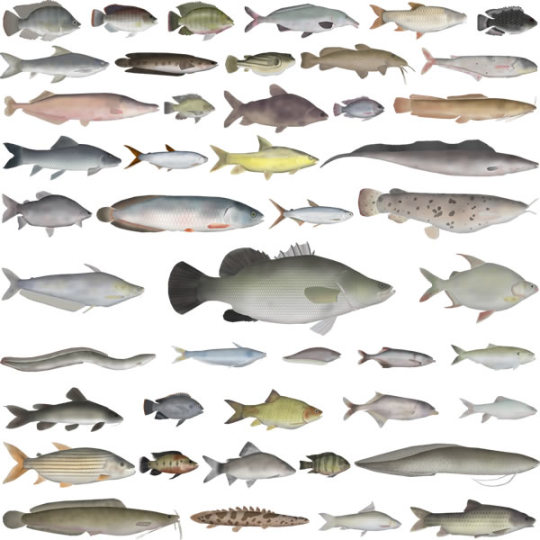
Nile River Basin Fish Group
Row 1: Nile Tilapia, Blue Tilapia, Redbreast Tilapia, Elephant Snout, True Big-Scale Tetra, Blue Spotted Tilapia
Row 2: Ningu, African Obsure Snakehead, Globe Fish, Giraffe Catfish, Ngai
Row 3: Cornish Jack, Mango Tilapia, Grass-eater, Singida Tilapia, North African Catfish
Row 4: African Carp, Silverides, Niger Barb, Aba
Row 5: Khraish, African Bonytongue, Characin, Electric Catfish
Row 6: Silver Catfish, Nile Perch, Moon Fish
Row 7: European Eel, Egyptian Butter Catfish, African Knifefish, Victoria Stonebasher, Twaite Shad
Row 8: Golden Nile Catfish, Victoria Tilapia, Labeobarbus surkis, Trunkfish, African Scraping Feeder
Row 9: Tiger Fish, Banded Jewelfish, Perch, Redbelly Tilapia, Marbled Lungfish
Row 10: North African Catfish, Saddled Bichir, Assuan Labeo, Ripon Barb
https://t.umblr.com/redirect?z=https%3A%2F%2Fwww.redbubble.com%2Fshop%2Fap%2F156144932&t=MWQ2MTVmNjA0ZDQ0N2UzMTUzYTJmNzk3ZTE4YjVhZDVjZDAyYmFiNCw3NzM1YTRiMjA4MDJkYzZmOTg0NTFhNDY3NjhkM2E0YWZiZTA5MDll&ts=1702664109
2 notes
·
View notes
Text
RAY FINNED FISH!!!!
extremely broad with so many good options
highlights below the cut

arapaima

ocean sunfish

australian lungfish

gar (particularly spotted gar)
a wizard is going to turn you into a random animal! whether you like it or not! how nice of them! spin the wheel to find out which class your new species belongs to (and then probably do a google).
#aquatic#text#i hope I didn't fuck up and put lobe finned fish in here#because some of these seem pretty lobe finned#but surely the internet wouldn't be wrong :)
27K notes
·
View notes
Text
Mabamba Swamp Birding Safari: Spot Uganda’s Iconic Shoebill Stork
Nestled along the northern shores of Lake Victoria, the Mabamba wetlands are a bird lover's dream and one of Uganda’s top bird-watching destinations. This tranquil, papyrus-lined haven offers an unmatched opportunity to spot over 260 bird species—including the elusive and iconic Shoebill Stork. A Mabamba Birding Safari is more than just an adventure—it's a soulful experience, where nature’s beauty unfolds with every paddle stroke through calm waters.
Why Choose Mabamba for Your Birding Safari? A visit to Mabamba is a must for anyone passionate about birds. Whether you’re an experienced ornithologist or a curious traveler with binoculars in hand, this wetland offers a truly immersive experience. From serene boat rides and early morning misty sightings to snapping rare photos of the prehistoric-looking Shoebill, the wetlands deliver unforgettable moments.

Unforgettable Bird-Watching Adventures Exploring the Mabamba wetlands is one of the highlights of a trip to Lake Victoria, especially for tourists staying in Entebbe. Sprawling across a vast stretch of papyrus swamp, Mabamba is recognized as one of Uganda’s Important Birding Areas (IBA) and was designated a Ramsar site in 2006, primarily to help protect the Shoebill and its habitat.
The Shoebill, known for its massive bill and dinosaur-era appearance, thrives here thanks to an abundance of lungfish, its preferred meal. With such ideal feeding conditions, sightings are common and often thrilling.
Other sites where you might spot the Shoebill in Uganda include:
• Lugogo Wetlands in the Zziwa Rhino Sanctuary
• Nile Delta in Murchison Falls National Park
However, Mabamba remains the most reliable spot to witness this rare bird in the wild.
A Bird List to Thrill Any Enthusiast Aside from the Shoebill, Mabamba wetlands are teeming with birdlife. You can expect to spot species such as:
• Blue Swallow
• Papyrus Gonolek
• Little Bee-eater
• Goliath Heron
• Slender-billed Gull
• Spur-winged Goose
• African Pied Wagtail
• Yellow-billed Stork
• Pied Kingfisher
• Fan-tailed Widowbird
• Blue-headed Coucal
And many more! In fact, 7 of the 12 Lake Victoria biome bird species are found here. From warblers to kingfishers and bee-eaters, the variety is astounding.
Migratory species can also be seen between November and April, making those months particularly fruitful for birding.
How the Safari Works Birding tours typically begin early in the morning around 7:00 AM, when bird activity is at its peak. Tourists venture into the swamp on canoes or motorized boats, expertly navigated through narrow channels by local or professional bird guides. These excursions can last a half or full day, depending on bird sightings and guest preferences.
Prices range from $50 to $120 per person, depending on the services included in your tour package—some of which may include hotel pickup, meals, and expert guiding.
Beyond Birds: More to Explore
The Mabamba experience isn’t just about birding. You can also:
• Take peaceful canoe rides through the lush swamp
• Visit the nearby Nkima Forest to see monkeys and forest birds
• Discover the local villages around Lake Victoria
These community visits offer cultural immersion—taste traditional dishes, purchase hand-crafted souvenirs, and learn about local customs and daily life.
You might also spot sitatunga antelopes, shy swamp-dwellers that occasionally make appearances during the quieter moments of your tour.
When to Visit While birding in Mabamba is possible year-round, the best months are:
• March • September • October • November
These months offer the perfect balance of bird activity and comfortable weather, with increased chances of spotting migratory species.

Where to Stay If you plan to stay near the wetlands, Nkima Forest Lodge is a great eco-friendly option offering easy access to the swamp. For those based in Entebbe, an early morning boat ride across Lake Victoria to Mabamba makes for a scenic and efficient start to your birding day.
Plan Your Mabamba Birding Safari with Nature Nest Safaris Let Nature Nest Safaris, a licensed and trusted tour agency in Uganda, guide you through this incredible adventure. Whether you're traveling on a budget or looking for a luxury birding holiday, they offer tailored tour packages to meet your needs. With professional guides, personalized service, and a commitment to excellence, you’re in good hands.
👉 For more information and to book your tour, visit www.naturenestsafaris.com
#Birding Safari#gorilla safari tour#Kenya wildlife safari#Mabamba Birding Safari#Safari Tour#tour#Tourism#travel#wildlife safari
0 notes
Text
Why Does the Shoebill Stork Look So Intimidating?
The shoebill stork, a massive bird found in the swamps of Central and East Africa, is known for its unusual and intimidating appearance. With its striking large beak and piercing eyes, this bird has become a subject of intrigue and sometimes fear. But why exactly does the shoebill stork look so intimidating? In this article, we'll delve deep into the characteristics that make this bird look fearsome and explore the reasons behind its formidable appearance.
The Shoebill Stork’s Distinctive Features: Exploring Its Intimidating Appearance
The shoebill stork stands out in the avian world due to its distinct features. These features contribute significantly to the bird's intimidating look. The most notable characteristic is its large, shoe-shaped beak, which gives the bird its name. This beak is not just large; it’s also powerful and is used effectively to hunt prey like lungfish, eels, and even small crocodiles. The beak alone can evoke a sense of fear, but combined with other physical traits, the shoebill stork’s overall appearance becomes even more striking.
The Power Behind the Beak: Why Size Matters
One of the most intimidating aspects of the shoebill stork is its enormous beak, which can grow up to 24 cm (9.4 inches) in length and 20 cm (7.9 inches) in width. This beak is not just for show; it’s a formidable tool that the shoebill uses to catch and kill its prey. The beak’s size and strength allow the bird to crush the skulls of large fish and reptiles with ease. The sharp, hooked tip of the beak further enhances its ability to grip and tear apart prey, making it a vital weapon in the shoebill’s hunting arsenal.
Piercing Eyes: The Shoebill’s Intense Gaze
Another feature that adds to the shoebill stork’s intimidating appearance is its piercing eyes. The bird’s eyes are large, with a striking yellow color that contrasts sharply with its grey-blue feathers. The shoebill's gaze is often described as unblinking and intense, which can be unsettling for those who encounter it. This intense gaze, combined with the bird’s slow, deliberate movements, gives the shoebill an almost predatory look, further adding to its fearsome reputation.
Towering Stature: The Size of the Shoebill Stork
The shoebill stork is one of the largest birds in the world, standing at about 120 to 150 cm (4 to 5 feet) tall. Its size alone is enough to make it an imposing figure in the wild. When combined with its large wingspan of up to 260 cm (8.5 feet), the shoebill’s presence becomes even more dominating. This towering stature allows the bird to survey its surroundings from a high vantage point, making it a formidable predator in its habitat.
Evolutionary Adaptations: Why the Shoebill Stork Developed Such Features
The intimidating features of the shoebill stork are not just for show; they are the result of millions of years of evolution. The bird’s large beak, for example, is an adaptation to its diet, which consists of large fish and reptiles. The shoebill’s piercing eyes allow it to spot prey from a distance, and its towering stature helps it navigate through the tall reeds and grasses of its swampy habitat. These adaptations have made the shoebill stork an efficient and effective hunter, but they have also contributed to its intimidating appearance.
The Shoebill Stork’s Behavior: How Its Actions Amplify Its Intimidating Look
While the physical features of the shoebill stork are intimidating on their own, the bird’s behavior further enhances its fearsome reputation. The shoebill is known for its slow and deliberate movements, which can give it an almost robotic appearance. This deliberate pace, combined with its intense gaze, creates an aura of menace that can be unsettling for those who observe it.
Slow and Steady: The Shoebill’s Methodical Hunting Technique
The shoebill stork’s hunting technique is one of the most fascinating aspects of its behavior. Unlike other birds that might dart quickly to catch their prey, the shoebill moves slowly and deliberately. It often stands still for long periods, waiting patiently for the right moment to strike. When it does move, it does so with precision, using its large beak to snatch up prey in one swift motion. This methodical approach to hunting adds to the bird’s intimidating presence, as it appears to be a creature that is always in control and never rushed.
The Shoebill’s Unique Bill-Clattering Sound: A Fearsome Display
In addition to its physical appearance and behavior, the shoebill stork has another trait that adds to its intimidating nature: its unique bill-clattering sound. When threatened or during mating displays, the shoebill will rapidly open and close its beak, creating a loud, clattering sound that echoes through its habitat. This sound, combined with the bird’s size and appearance, can be quite frightening, especially when heard in the wild.
Territorial Behavior: How the Shoebill Stork Defends Its Domain
The shoebill stork is a solitary bird that is highly territorial. It will aggressively defend its territory from other birds and even humans if it feels threatened. This territorial behavior is another aspect of the shoebill’s intimidating reputation. The bird’s large size and powerful beak make it a formidable opponent, and its willingness to stand its ground only adds to its fearsome image.
The Shoebill Stork’s Habitat: How Its Environment Shapes Its Appearance and Behavior
The shoebill stork’s intimidating appearance and behavior are closely tied to its environment. The bird is native to the swamps and wetlands of Central and East Africa, where it has adapted to life in a challenging and often dangerous habitat. Understanding the shoebill’s environment can provide insight into why it looks and acts the way it does.
Life in the Swamps: The Shoebill’s Natural Habitat
The shoebill stork is primarily found in the swampy regions of South Sudan, Uganda, and parts of the Democratic Republic of the Congo. These wetlands are rich in biodiversity, but they are also home to many predators, including crocodiles and large snakes. The shoebill’s large size, powerful beak, and intimidating appearance are all adaptations that help it survive in this harsh environment.
Camouflage and Stealth: The Shoebill’s Survival Strategies
In addition to its physical features, the shoebill stork has developed several behavioral adaptations to survive in its environment. One of these is its ability to remain still for long periods, which allows it to blend in with the tall reeds and grasses of its habitat. This stealthy behavior helps the shoebill avoid detection by predators and prey alike. The bird’s grey-blue feathers also provide camouflage, helping it blend into the misty, swampy environment where it lives.
The Role of Water in the Shoebill’s Hunting Technique
Water plays a crucial role in the shoebill stork’s hunting technique. The bird often hunts in shallow water, where it can wade through the reeds in search of prey. The shoebill’s large feet are well-adapted for this purpose, allowing it to move quietly through the water without creating much disturbance. This stealthy approach, combined with its powerful beak, makes the shoebill an efficient hunter in its watery habitat.
The Shoebill Stork in Culture: How Its Intimidating Look Has Influenced Human Perception
The shoebill stork’s intimidating appearance has not gone unnoticed by humans. Throughout history, the bird has been the subject of fascination and fear in various cultures. Its unique look and behavior have inspired myths, legends, and even modern-day pop culture references.
The Shoebill Stork in African Folklore
In some African cultures, the shoebill stork is considered a symbol of power and strength. Its large size and fearsome appearance have led to its inclusion in various myths and legends. In some stories, the shoebill is seen as a guardian of the wetlands, a creature that protects its territory with fierce determination. In other tales, the bird is viewed as a harbinger of doom, a creature whose presence signals danger or death.
The Shoebill Stork in Modern Pop Culture
In recent years, the shoebill stork has gained popularity on social media and in pop culture. Its unusual appearance has made it a subject of memes and viral videos, where it is often portrayed as a “scary” or “creepy” bird. This portrayal has only added to the bird’s intimidating reputation, as more people become aware of its fearsome look.
The Shoebill Stork as a Symbol of Conservation
Despite its intimidating appearance, the shoebill stork is also a symbol of conservation. The bird’s habitat is under threat from human activities such as agriculture, logging, and pollution. As a result, the shoebill stork is now considered a vulnerable species, with only a few thousand individuals remaining in the wild. Conservationists are working to protect the bird’s habitat and ensure its survival for future generations.
Conclusion: Understanding the Shoebill Stork’s Intimidating Appearance
In conclusion, the shoebill stork’s intimidating appearance is the result of a combination of physical features, behavior, and environmental adaptations. Its large beak, piercing eyes, and towering stature all contribute to its fearsome look, while its slow, deliberate movements and territorial behavior enhance its reputation as a formidable bird. However, it is important to remember that the shoebill stork is also a symbol of strength and resilience, a creature that has adapted to survive in one of the most challenging environments on Earth. By understanding the reasons behind its intimidating appearance, we can appreciate the shoebill stork for the fascinating and unique bird that it is.
1 note
·
View note
Note
Took me 4 or 5 times before I realized you had reblogged "they're only called spotted lungfish when you see them" a bunch of times, and it wasn't just Tumblr showing me posts id already seen over and over lol
i only reblogged that one once thoufh
0 notes
Text
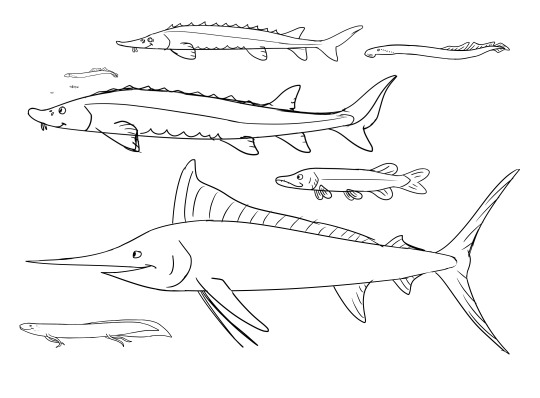
More fish! The only one that matches the Altantic sturgeon's massive size, a black marlin at 4 meters exactly (larger than average)! The biggest black marlin ever caught was 4.65 meters, good cod how massive is that TToTT The other fish are slender/spotted lungfish at 130 cm (max length), a European river lamprey at 45 cm (bigger than average), a sand goby at 8 cm (max size), and a sea lamprey at 120 cm (max size)

I thought it would be fun to draw some fish I like in proper scale to one another. You never really put two and two together about the absolute sizes of some animals until you see them compared to other things! I've already done four off the top of my head:

An Atlantic sturgeon that's 3 meters long (modern Atlantic sturgeons rarely reach sizes over 2.4 m, but historically they could be up to 4 meters. I settled on an in between length), a northern pike that's 120 cm long (upper estimate), a Siberian sturgeon that's 2 meters long (absolute max size), and a neon tetra that's 3 cm long (average length)!
If you need help seeing the neon tetra, here's it is with the Atlantic sturgeon:

#unsure if i will ever render these but it could be fun#my own fish poster :3#one that you will have to zoom in on to see every fish but one nevertheless#maybeee next i will do a zebra shark? or another small fish#ill have to think about which fish i really like#marlin#black marlin#lamprey#sea lamprey#european river lamprey#spotted lungfish#slender lungfish#sand bogy#goby#surprise i actually really like the sand goby too#lil guy. little friend.#another buddy i dont get to mention much#art#my art
746 notes
·
View notes
Note
whats your favorite animal and favorite dinosaur (or non dinosaur if your fave is a dinosaur)
My favourite dinosaur is probably the magpie but i presume you meant non-avian dinosaurs, which makes the answer more difficult, but I do like dromaeosaurs in general though I don't think I can pick just one genus; besides those, t rex is just really cool, but again, i really can't pick a genus to be my fave. If i had surviving non-avian dinosaurs in an area I live in this would be easier because I'd just pick some that i see a bunch.
As to animals in general, a single answer is also difficult but some options in no particular order include: red fox, house cat, european wildcat, sandcat, orca, european bison, magpie, jackdaw, azhdarchid pterosaurs in general (if i have to pick one, mmmm, lets say hatzegopteryx), saltwater crocodile, anura in general (if i have to pick one, lets go with the european toad, simply because its the one that i most frequently see, giving me the opportunity to go "woahj frog"), lungfish, coelacanth, bluefin tuna, northern pike, bumblebees in general, seven-spotted ladybugs, horseshoe crab, tardigrades in general, loricifera in general, common garden snail, great pond snail, siphonophores in general, and my girlfriend
1 note
·
View note
Text






Round 1 and 2 art from the Animal Engineers division! Cathedral termite round 1 White-spotted pufferfish round 1 Palaocastor round 1 & 2 Sydney brown trapdoor spider round 1 Spotted lungfish round 2
#art#my art#2023mmm#March Mammal Madness#cathedral termite#pufferfish#white-spotted pufferfish#Palaeocastor#trapdoor spider#sydney brown trapdoor spider#slender lungfish#african spotted lungfish#not animated#not animation
12 notes
·
View notes